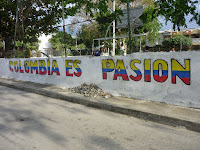Now, if anybody is paying close attention, or is even reading these blogs, you may notice an anomally with today's posting. A careful look at the map of Argentina clearly shows that Cordoba is before Salta, if heading north. Yet my Salta blog was last week. Yeah, yeah I know, just bear with me. I don't even know what day it is sometimes, let alone remember what town I'm in.
So, let's deal with Cordoba. A city I was highly anticipating due to the fact that it is a colonial town that has preserved many of it's buildings from that period.
The trip from Mendoza once again took myself and Grace through Andes and another brush with the border control. Although these are fairly painless, it always takes longer than it should and seems so inefficient. The process definitely needs a LEAN or Six Sigma approach applying.
The journey from Valparaiso entailed a 10 hour bus journey to Mendoza, a 6 hour wait in Mendoza, then an 11 hour overnight bus to Cordoba. Those buildings better be bloody breathtaking to make all this worthwhile. And the abiding memory of the journey? The obese, badly dressed, builder's arse showing bloke on the seat opposite, snoring like a trooper. It got so bad at one point Grace actually shook him, woke him up and shouted at him. The look of surprise on his face! Priceless. With his shirt riding over his ample stomach, and the bouncing of the bus, we had a constant “truffle shuffle” to keep us entertained.
We arrived at 8am and got a cab to Palenque Hostel, which turned out be a very friendly hostel, just indicative of most city hostels in that there were not many places to chill with a book or a beer. The favourite activity of most of the backpackers there seemed to be to watch telly, loudly, from 9am in the morning. Honestly, kids, there is a whole wide world out there! And yes, despite claiming in previous blogs that I was finished with dorms, in Cordoba I shared a 6 bed dorm with 5 attractive Dutch girls. Worse ways to spend 3 days. I suppose!!

Cordoba did in fact turn out to be a good example of an old colonial town, with well preserved buildings and churches scattered around the centre. That said, the development in the town, not all good, overshadows some of the amazing architecture. The main square, Plaza San Martin, is surrounded by shops and cafes with the biggest, ugliest billboards you will see. Hardly an aesthetic contrast to the Igelisa Catedral, begun in 1577 and crowned with a Romanesque dome.
Day 2 in Cordoba we decided to head into the hills, to Alta Gracia, 35kms from Cordoba. A colonial mountain town and home to an adolescent Ernesto “Che” Guevara in the 1930's. His home from that time, Villa Beatriz now houses the excellent Museo Casa Ernest “Che” Guevara. The museum documented his trips around Argentina and South America, the most famous being the one that made it onto the big screen as “The Motorcycle Diaries”. It also showcased many photos from his childhood and, from later years, copies of very moving letters that he sent to his children whilst he was overseas, mostly in Cuba, freedom fighting.


Also in Alta Gracia we visited the Iglesia Parroquial Nuestra Senora de la Merced, built by the Jesuits between 1643 and 1762. Amazing to walk amongst the various buildings, imagining people all those years ago walking the same path.

In all, we had a very good 3 days in Cordoba but I was looking forward to heading off, on the road again, in search of something that captures my imagination just a little bit more.
And it was the end of the travel road for myself and Grace. End of a very enjoyable two weeks. A two weeks in which we had established a familiar drinking routine, both of us enjoying a drink. We would have the litre before dinner, as a “sharpener”, have dinner, then have more beer, to see out the evening. Who will I say “salut”, or “un ronda mas?” with now Graciela?
Oh well, such is the traveller's life, always transient. We said our farewells as I got into a cab for my overnight bus to Salta, whereas Grace was headed back to Buenos Aires and a flight back to Holland. Not all sad for Grace though, three days at home and she was heading back on a plane for a holiday in Cuba. Thats the life!
For me, well you know what I did. If you read my previous post that is. I went to Salta! Next time, I hope to have my blog posts in order, so we should be reading about San Pedro de Atacama, one of the driest deserts in the world.
Chao chicas!

















































